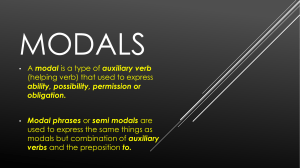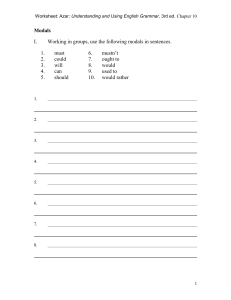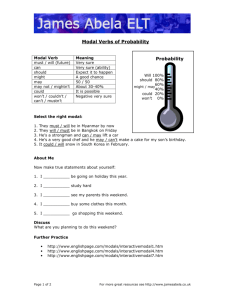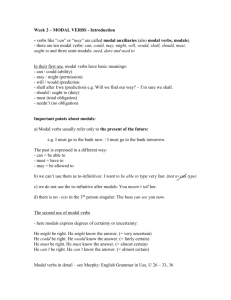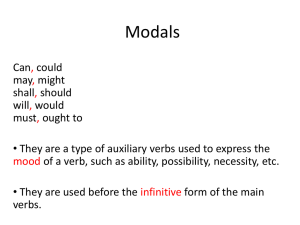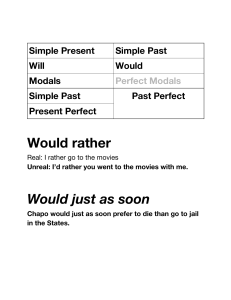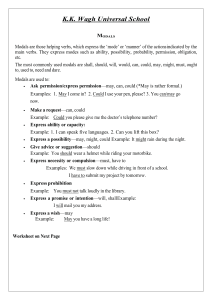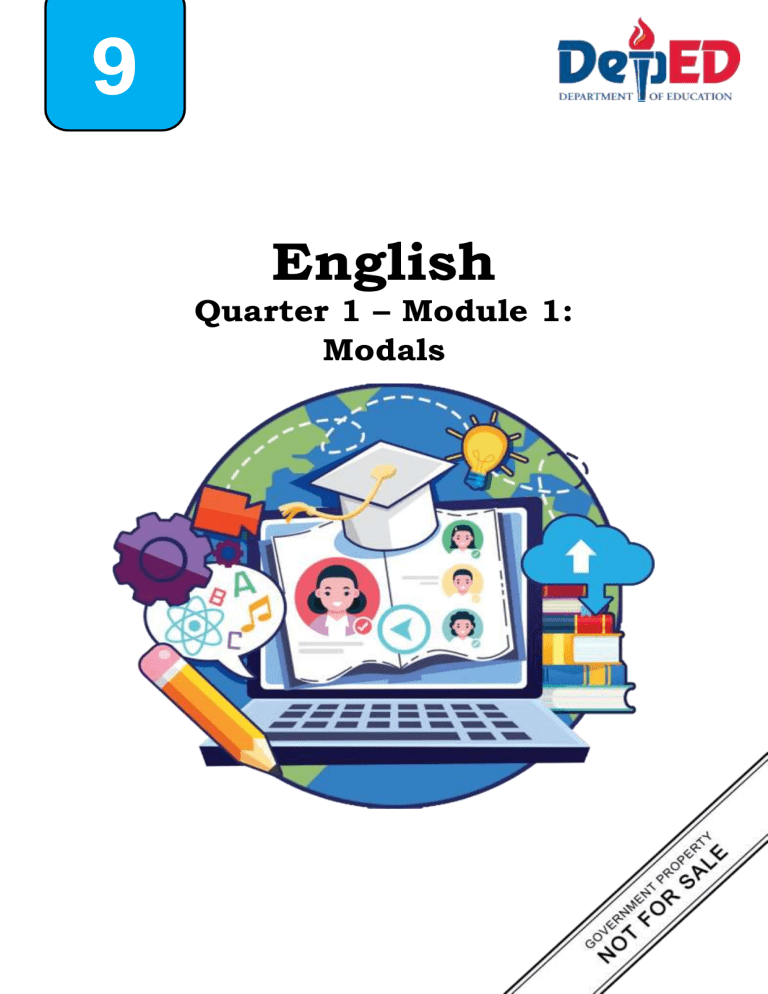
9 English Quarter 1 – Module 1: Modals English – Grade 9 Alternative Delivery Mode Quarter 1 – Module 1: Modals First Edition, 2020 Republic Act 8293, section 176 states that: No copyright shall subsist in any work of the Government of the Philippines. However, prior approval of the government agency or office wherein the work is created shall be necessary for exploitation of such work for profit. Such agency or office may, among other things, impose as a condition the payment of royalties. Borrowed materials (i.e., songs, stories, poems, pictures, photos, brand names, trademarks, etc.) included in this module are owned by their respective copyright holders. Every effort has been exerted to locate and seek permission to use these materials from their respective copyright owners. The publisher and authors do not represent nor claim ownership over them. Published by the Department of Education Secretary: Leonor Magtolis Briones Undersecretary: Diosdado M. San Antonio Development Team of the Module Writer: Bonifacio B. Pajarillo, Jr Editors: Jojane N. Gelbolingo & Ramil R. Cubelo, PhD Reviewers: Shiela C. Alemania Illustrator: Ivory Joan M. Tambala, Ramel E. Ligue, & Katrina O. Quizan Layout Artist: Melanio R. Florino Jr. Management Team: Reynaldo M. Guillena, CESO V Basilio P. Mana-ay Jr., CESE Emma A. Camporedondo, CESE Alma D. Cifra, EdD May Ann M. Jumuad, PhD Aris B. Juanillo, PhD Printed in the Philippines by Department of Education – Region XI Office Address: Telefax: E-mail Address: Elpidio Quirino Ave., Poblacion District, Davao City, 8000 Davao del Sur (082) 224-3724, (082) 222-1672 davao.city@deped.gov.ph 9 English Quarter 1 – Module 1: Modals Introductory Message For the facilitator: Welcome to the English 9 Alternative Delivery Mode (ADM) Module on Modals! This module was collaboratively designed, developed and reviewed by educators both from public and private institutions to assist you, the teacher or facilitator in helping the learners meet the standards set by the K to 12 Curriculum while overcoming their personal, social, and economic constraints in schooling. This learning resource hopes to engage the learners into guided and independent learning activities at their own pace and time. Furthermore, this also aims to help learners acquire the needed 21st century skills while taking into consideration their needs and circumstances. In addition to the material in the main text, you will also see this box in the body of the module: Notes to the Teacher This contains helpful tips or strategies that will help you in guiding the learners. As a facilitator, you are expected to orient the learners on how to use this module. You also need to keep track of the learners' progress while allowing them to manage their own learning. Furthermore, you are expected to encourage and assist the learners as they do the tasks included in the module. 1 For the learner: Welcome to the English9 Alternative Delivery Mode (ADM) Module on Modals! The hand is one of the most symbolized part of the human body. It is often used to depict skill, action and purpose. Through our hands we may learn, create and accomplish. Hence, the hand in this learning resource signifies that you as a learner is capable and empowered to successfully achieve the relevant competencies and skills at your own pace and time. Your academic success lies in your own hands! This module was designed to provide you with fun and meaningful opportunities for guided and independent learning at your own pace and time. You will be enabled to process the contents of the learning resource while being an active learner. This module has the following parts and corresponding icons: What I Need to Know This will give you an idea of the skills or competencies you are expected to learn in the module. What I Know This part includes an activity that aims to check what you already know about the lesson to take. If you get all the answers correct (100%), you may decide to skip this module. What’s In This is a brief drill or review to help you link the current lesson with the previous one. What’s New In this portion, the new lesson will be introduced to you in various ways such as a story, a song, a poem, a problem opener, an activity or a situation. What is It This section provides a brief discussion of the lesson. This aims to help you discover and understand new concepts and skills. What’s More This comprises activities for independent practice to solidify your understanding and skills of the topic. You may check the answers to the exercises using the Answer Key at the end of the module. What I Have Learned This includes questions or blank sentence/paragraph to be filled in to process what you learned from the lesson. What I Can Do This section provides an activity which will help you transfer your new knowledge or skill into real life situations or concerns. 2 Assessment This is a task which aims to evaluate your level of mastery in achieving the learning competency. Additional Activities In this portion, another activity will be given to you to enrich your knowledge or skill of the lesson learned. This also tends retention of learned concepts. Answer Key This contains answers to all activities in the module. At the end of this module you will also find: References This is a list of all sources used in developing this module. The following are some reminders in using this module: 1. Use the module with care. Do not put unnecessary mark/s on any part of the module. Use a separate sheet of paper in answering the exercises. 2. Don’t forget to answer What I Know before moving on to the other activities included in the module. 3. Read the instruction carefully before doing each task. 4. Observe honesty and integrity in doing the tasks and checking your answers. 5. Finish the task at hand before proceeding to the next. 6. Return this module to your teacher/facilitator once you are through with it. If you encounter any difficulty in answering the tasks in this module, do not hesitate to consult your teacher or facilitator. Always bear in mind that you are not alone. We hope that through this material, you will experience meaningful learning and gain deep understanding of the relevant competencies. You can do it! 3 What I Need to Know In this module, you are expected to learn about modals. Learning the usage of modal appropriately will not just improve sentence structure but also on the effectiveness of the content of the sentence. This will help your ideas flow logically and comprehensively. The language used recognizes the diverse vocabulary level of students. The lessons are arranged to follow the standard sequence of the course. But the order in which you read them can be changed to correspond with the textbook you are now using. After going through this module, you are expected to: 1. Use modals in the sentence correctly. 2. Identify appropriate modals and its functions in a sentence 3. Construct sentences with appropriate modals. 4 What I Know Let us explore modals by answering the 15-item quiz. Initially, do not worry if you commit some mistakes, for you will be guided step-by-step leading to your full understanding of our lesson. Let us see if you can answer this. Read the following sentences and identify which of the choices or appropriate modal word should be used to complete the statement. Just encircle the correct modal word in each of the given items. I (can, could) write compound sentences. 2. When I was young, I (can, could) eat tons of cupcakes! 3. The students (must, may) finish their assignments by Wednesday. 4. It (must, may) rain later. 5. If it is sunny outside, I (will, would) be much happier! 6. He (shall, should) go to the isolation facility. 7. You (must, might) abide the health protocol. 8. We (cannot, could not) simply underestimate the recent pandemic. 9. After the high figure of Covid 19 positive cases in some areas in Davao City, the Mayor (must, might) declare local hard lockdown. 10. During pandemic, we (should, shall) be mindful of wearing face mask, social distancing and other health protocol. 11. If you are the owner of this dog, you (shall, should) be able to tell us which of its eyes is blind. 12. I (must, might) do something to solve the global crisis. 13. (Will, Would) you drink with me? 14. (Shall, Should) we welcome repatriates? 15. In the near future, human (may, might) colonize another planet. 1. You just started your journey on modal words surprisingly. Don’t worry, the rest of this module will show you several ways on how to use modals accurately and correctly. 5 Lesson 1 Modals: Express permission, obligation, and prohibition The goal of module 1 lesson 1 is not only for the learners to be acquainted with its different parts but also on the adaptability on a selfinstructed, self-paced exercise. Learners, you are very welcome to explore as you walk through the guided series of activities leading to its module functionality. What’s In Today, as you continue working on the different learning tasks on modal words, your competence on constructing grammatical sentences will be developed. Have fun today! Activity 1 Roller Skate at the Park Study the conversation between two friends in the park. Ramel: It’s so great that you can roller skate, Geterel! Geterel: I wish I could do it, too! It must be terrific! 6 Ramel: Don’t worry, I will teach you soon. After few hours of roller skating in the park. Geterel: Shall we go home now, Ramel? Ramel: Could we stay a little bit longer, please? Geterel:(phone ringing) Oh that might be your mom. Ramel: Yes, she is. She must be worried because I didn’t ask permission. What does the italicized words mean? Yes! They are called modals. We will learn further about modals and its various functions as we go through with your first module. What’s New As we begin exploring, this time, we will read the excerpt from “The Analects and Zen Parables: The Thief Who Became a Disciple”: “Spare me your mercy. I will need some to pay the tribute that is requested by the King. His only anxiety is lest he should fail to recognize theirs. I would say, “Let there be no evil in your thoughts. They will keep their self-respect and come to you of their own accord. You, shall teach you what knowledge is?” Comprehension Questions: Read the following questions and encircle the letter of the correct answer. 1. What values are present in the paragraph above? a. justice and fairness b. hard work and industry c. humility and compassion d. nationalism and heroism 2. What do you mean by the line “Let there be no evil in your thoughts”? justice and fairness a. We should always set our mind positively. b. We should find ways to fight against tempt us. c. We should be resilient in every adversity that comes our way. d. We should think of the goodness and good things for our brothers. 7 3. What is the author’s purpose of the text? a. To inform on the goodness of humanity b. To inspire others to be one with nature. c. To convince that mercy and compassion would make a better world. d. All of the above This time, focus your attention to the underlined words in every sentence of the excerpt, what do underlined words in common? What do we call this expression? Yes, you are correct! It is modal. Which of them indicates simple futurity, obligation, and prohibition? Check your answers using the key to corrections. The underlined words in the excerpt that you have just read are examples of modals. What is It Now learner, your few questions in the previous activities will be answered shortly. The concept of modals will be explained in detailed with examples for you to be guided. Let’s gear up learner! 8 Modal verbs or modal auxiliary verbs are a type of verbs that indicates modality, i.e., likelihood, permission, ability and obligation. Some of the common modal verbs are can, could, may, might and must. They are a kind of special verbs which behave very irregularly in English. Modals cannot be represented alone as a main verb since they are always used in the helping form. Let’s learn them one by one and take another step towards English fluency. https://english.eagetutor.com/spoken-english-grammar/modal-verbs-and-its-types Can and Could These modal verbs are usually used to show ability. We use CAN to talk about things that we are able to do in the present or the immediate future. For example: 1. She can help you with your homework later today. 2. They can dance all night long! We use COULD to talk about what we were able to do in the past. We also use COULD for polite requests. For example: 1. Long ago, people could travel without permits. 2. Could you pass me the sugar, please? 3. If we have enough time, we could go to the playground later. 9 Must, Might, and May These modal verbs are usually used to express obligation and possibility. We use MUST to talk about obligations and when we are sure something is true. For example: 1. You must eat your fruits! 2. He is not home yet. He must be stuck on a traffic. We use MIGHT and MAY to say that something is possible, but not sure. We also use MAY to talk about approval. For example: 1. The kids might like potato, but I'm not sure. 2. This might be the most difficult decision he couldever do. 3. You may choose any gift that you like best. 4. You may have a chocolate after dinner. Should We use SHOULD as modal verb to talk about obligation. For example: 1. It's a beautiful day! We should take a walk outside. Will, Shall, and Would We use WILL and SHALL to talk about the future, especially for predictions and promises. Remember that we only use shall for the first person (I or we). 10 For example: 1. I shall arrive home late this morning. 2. She will be able to buy some new dress soon. 3. I will chat you later. We use WOULD in conditionals and for polite requests. For example: 1. Would you please solve this problem? 2. If we had a lot of money, we would go on vacation every day! The negative forms CANNOT/CAN’T, MUSTN’T and MAY NOT (more formal) are used to express prohibitions: 1. I'm sorry, but you can't stay here. 2. You mustn't touch that Ming vase. 3. Non-committee members may not vote on committee issues. Used in the negative, BE to can also express prohibitions: SENTENCE RELATED TO THE ILLUSTRATION 11 What’s More Let’s proceed to the application of our learnings. In this activity, your knowledge on modals and its functions will be solidified through series of test items. Let’s go learner, have fun! Choose the correct modal words to complete the following sentences. 1. I (can, could)go to the party this evening. 2. A:(Can, Could) B: Yes, he Noel cook Italian food? (can, could). 3. You(will, would) see that I am right. 4. (Shall, Should) I open the door? 5. She knows, she (must, might) be there. 6. You (may, might) leave if you wish. 7. My sister 8. They (can, could) sing together very well. 9. Which pen 10. He (can, could)speak English fluently. (shall, should) I buy? (will, would) talk about nothing but movies. B. Complete the paragraph by writing the appropriate modals. I have been to the different countries; however, I feel I (1) (may, might) not be doing so in the coming days. Recently, I got a new office position that (2) (will, would) demand most of my time. I (3) (shall, should), however, delegate most of my works. After a year or so, I (4) (will, would)think of continuing with my travel business since I (5) (may, might) have covered most of the work that I need to cover now. What I Have Learned It’s another day of embracing new learning and learning opportunity. After various activities, you are expected to take this learning task so easily. Have fun, learner! 12 Complete the concept definition by supplying the correct term to form the given concept. A is a type of verb that is used to indicate modality – that is: likelihood, ability, permission, request, capacity, suggestions, order, prohibition obligation, or advice. Say something about the table. FUNCTION MODAL ability can, past ability, suggestion could EXAMPLE Darwin can sing, dance and act. He could speak fluent Bahasa when he was 8. permission, approval may, possibility might He may borrow my Journalism book. The teacher said he might be late. Offer or suggestion shall, I should solve this equation Advice, uncertain should book by Monday prediction Willingness, certain will, predictions or promises Request, invitation or You will see that you are wrong. would making arrangement prohibition You shall return this He would stand for hours talking to himself. 'can't' and 'mustn't' (must You can't go into that not) are used to show facility without a health that something is clearance. prohibited (not allowed) You can't drive in across 'Can't' usually gives the Davao Region border idea of something that is without a travel authority against the rules. Mustn’t pass. 13 usually means that it is the speaker who is setting the rule. Remember that are used as auxiliary or helping verbs with special functions. These verbs help speakers and writers express their attitude to what they speak or write about. verbs are used to express responsibility, obligation, probability, etc. What I Can Do As you take this exciting part of the module, we will have self-check on how far you can go on modal usage and apply the skill into real life situation. Take your time learner! A. Complete the sentences in the paragraph with appropriate modals. 1. When I talk to you about the company report? 2. Most dinosaurs walked on land, but some fly or even swim. 3. I hear your soft voice clearly. 4. I drive a truck when I was only sixteen years old. 5. She sit for hours talking to herself. would should Either could be used here. 6.You keep your promise. would should Either could be used here. 7. They be rich to live in such a house. 8. She be at home this time. 9. 10. You God give you long life! pay your taxes. 14 B. Complete the paragraph below using the appropriate modal. Seeing a crow eating a piece of bread a fox thought how it (1) trick that fellow. It said, “(2) fox again said, “(3) I talk to you, Sir?” The crow did not even look at the fox. The you please pay a little attention to me? What a nice bird you are! Your voice (4) be very sweet. I am sure you (5) sing very well.” C. List down reminders pertaining to the use of gadget/s set by your parents at home (Construct your sentences using modal of obligation shall, should) D. Create a bond paper size poster on how you can help the government on their Stay at Home Campaign productively (Construct your sentences using modal of prohibition, can’t, mustn’t) 15 Assessment Your teacher-facilitator is happy that you have come to the evaluation part of this module. By taking these series of test items we will measure how well did you master modals and its functions. Have fun learner! A. Complete the sentences in the paragraph with appropriate modals. 1. Douglas eat pizza all day long. 2. How many hot dogs 3. I 4. 5. We you eat at one time? read without my reading glasses. we play tennis, Mommy? fail, but let’s not think about it 6. We agreed that it 7. He not use the car. 8. Long ago, people 9. be dangerous travel without permits. you pass me the sugar, please? 10. If we have enough time, we go to the playground later. B. Complete the following sentences by writing the appropriate modal words. After you have answered the ten-item assessment test, read carefully the instructions below to complete the table on modal words and its functions. 1. I didn’t feel very well yesterday. I 2. You look at me when I am talking to you. 3.I was using my pencil a minute ago. It 4. Already as a child Mozart 5.You really not eat anything. be here somewhere! play the piano beautifully. not be late again. 6.If you don’t start working harder, you 16 repeat the course next year. 7.His parents spoil him. He’s always 8.Phone her now. She allowed to do whatever he wants. be home by now. 9. I help you, but I don’t want to. 10.I be able to help you, but I’m not sure yet. C. Write down the identified modal words from the ten-item assessment test above and identify its functions. Write your answer on the table below. Item 1 is done for you.Take your time learner! Modal 1 Could Function Ability 2 3 4 5 6 7 8 9 10 17 Additional Activities Great day to you dear learner! To enrich your skill and measure how well you understood the modal usage concept, another exciting activity is prepared for you. Have fun! Fill in the blanks with appropriate modals. 1. A: B: Yes, I 2. Ellie 3. I 4. 5. She 6. That 7. you read when you were four years old? . ride a bicycle. She rides it to school every day. go out to the park to play because of the good weather. you see the moon last night? sit for hours listening to the radio. will shall be the postman, I think. will shall Either could be used here you have tea? Will Shall Either could be used here 8. you lend me your scooter? Will Shall Either could be used here 9. We finish it on time. 10. There be rain today. 18 B. Complete the sentences in the paragraph with appropriate modals. (Will / Shall, Would/ Should or Can/Could, May/Might) Man 1 live without food and water for some time, but he/she 2 not live without air. We 3 foul or polluted air 4 inhale pure, oxygen-rich air. Breathing cause chest related problems. Exposure to cold air 5 be avoided. When a person catches cold, he 6 and easily digestible food. He 7 circumstances. He 8 take simple, light avoid going out in cold under all to keep his body warm by putting on woolen clothes. 19 Answer Key 20 21 References Almonte, L.R. et.al. (2015). Celebrating Diversity through World Literature: EnglishLearner’s Material. Pasig City. REX Book Store, Inc., Department of Education –Instructional Materials Council Secretariat (DepEd – IMCS) Edumantra: Best CBSE Knowledgebase (2012). Gap filling Exercises.Retrieved on June 9, 2020 athttps://edumantra.net/grammar/gap-filling-exercises-forclass-9-10-solvedexercise-910/ Learn24X7. 2020. Learning made easy and simple. Retrieved on June 8, 2020 at https://www.lessonenglishgrammar.com/usage/modals-types-exercises-forpractice-for-use-of-modals/ Madan, Chander. (2015, July, 20). Modal verbs and its types. Retrieved on June 9, 2020 https://english.eagetutor.com/spoken-english-grammar/modal-verbsand-its-types 22 For inquiries or feedback, please write or call: Department of Education–Region XI Davao City Division Elpidio Quirino Avenue, Davao City, Davao del Sur, Philippines Telephone: (082) 224 0100 / 228 3970 Email Address: info@deped-davaoc2it3y.ph / lrmds.davaocity@deped.gov.ph

